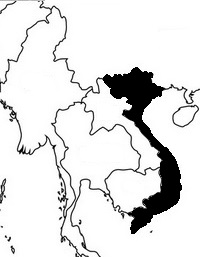Vietnamese Walking Sticks
Medauroidea extradentata
- Habitat: sub-tropical dry and wet forests
- Range: endemic to Vietnam
- Natural Diet: leaves of vegetation they inhabit, in Vietnam.
- Status in the Wild: Not evaluated
All about the Vietnamese Walking Stick Insects
Vietnamese or Annam Walking Stick Insects also known as stick bugs are one of the largest species of cockroaches in the world reaching a length of three inches. They have a rust and black-colored segmented thorax and abdomen. Their exoskeleton is thick and hard and their heads, antennae, and legs are black in color. Unlike most other cockroaches, the Vietnamese Walking Stick Insects are wingless. Their feet have hooks on them that help them climb smooth surfaces. They are active by night (nocturnal).
Although males and females have the same color and form, there are some differences between them. The males have two bumps on their heads that are either very small or non-existent in the females. Another distinguishing feature is regarding the last segment in the abdomen; the females have a large last segment while in the males this area contains three smaller segments.
Diet/ Habitat/ Range
Vietnamese Walking Stick Insects are native to and only found in Madagascar (endemic) living in dry leaf litter on the floor of tropical rainforest habitats. They mostly feed on fruit and plant material since it is readily available. They also scavenge on animal carcasses.
Behavior
The Vietnamese Walking Stick Insects make a
unique hissing sound that deters predators. This sound is made by
them by forcing air to pass through their respiratory spiracles that
are located along the sides of the abdominal segments. They emit
four types of hisses with one of them being an alarm hiss to deter
predators. Two types of hisses are emitted during courtship and the
last (called the male combat hiss) is emitted only by males when
they compete with other males.
Male hissers are territorial by nature and compete with other males
for their space and females. They compete by hissing at one another
and by looking larger than their competition which is done by
standing on the tips of their toes called stilting. They also use
the bumps on their heads to push and shove their competition away.
Females and nymphs do not fight with each other and are more social.
Reproduction
Vietnamese Walking Stick Insects breed year around when the weather is warm. Males emit a calling hiss and a courtship hiss during their courtship displays to attract females. While the calling hiss is a long-distance call to attract females, the courtship hiss is one that is emitted by the male when the female is in close range. Males are attracted by a female’s odor which is monitored through sense organs located on their antennae. After the eggs are fertilized, the female carries an egg case but delivers live nymphs (larval stage). This process is called ovovivipary. A female can deliver 15 to 40 nymphs after mating has occurred. These nymphs are creamish-white in color and look similar to the adults but are much smaller in size. The process is called incomplete metamorphosis where the nymphs and adults are similar with only a size difference. Since these cockroaches and their nymphs have a hard exoskeleton, when they grow, they shed their hard exoskeleton and are creamish-white in color. Once they have grown to a larger size a new exoskeleton hardens around their thorax and abdomen. This process is called molting. During the life cycle of a Madagascar Hissing Cockroach, nymphs molt multiple time before they reach adulthood.
